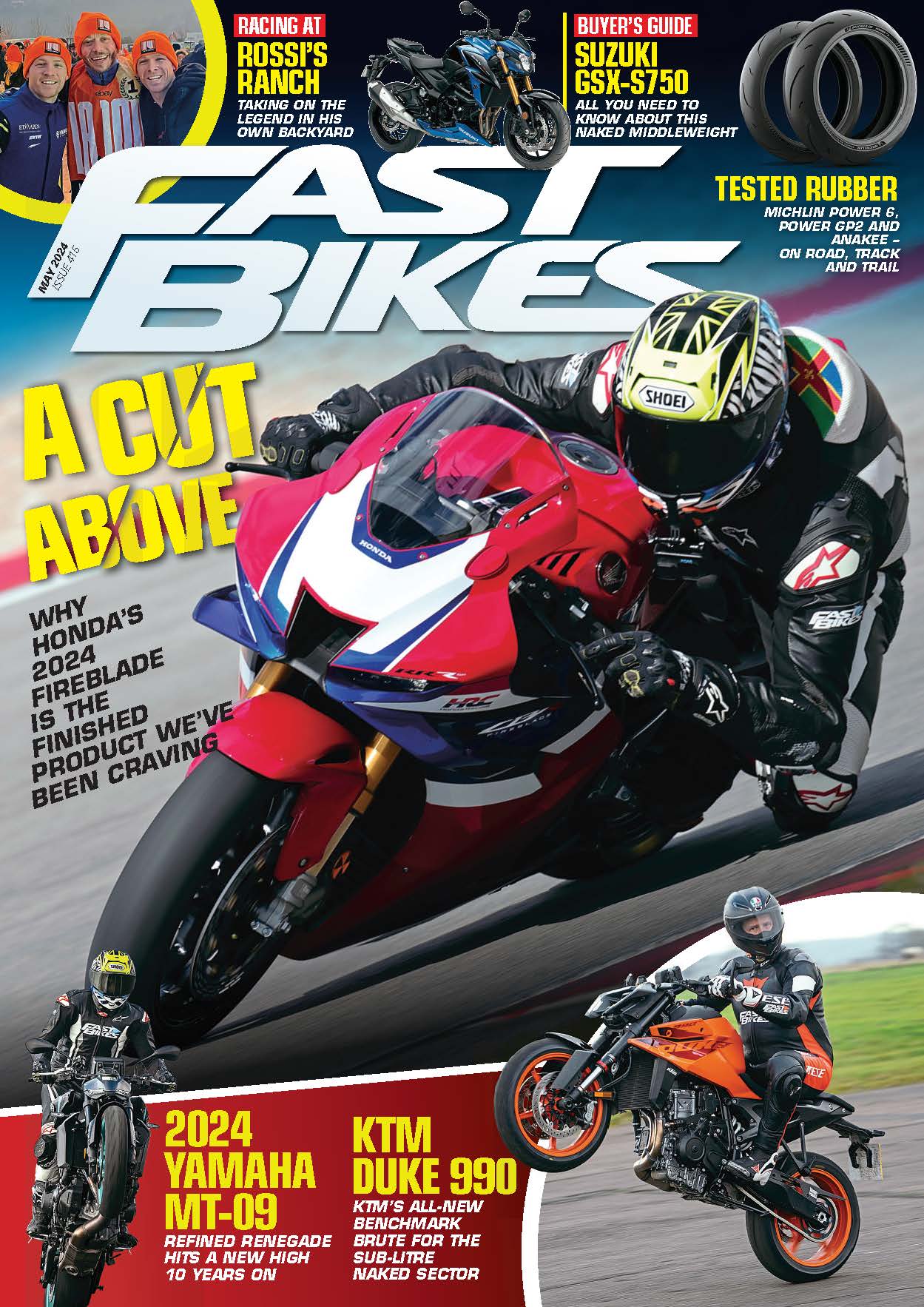Just under a decade ago, Ducati pulled the covers off a very special supersport bike. Here’s Timmy’s take on the iconic 749R.
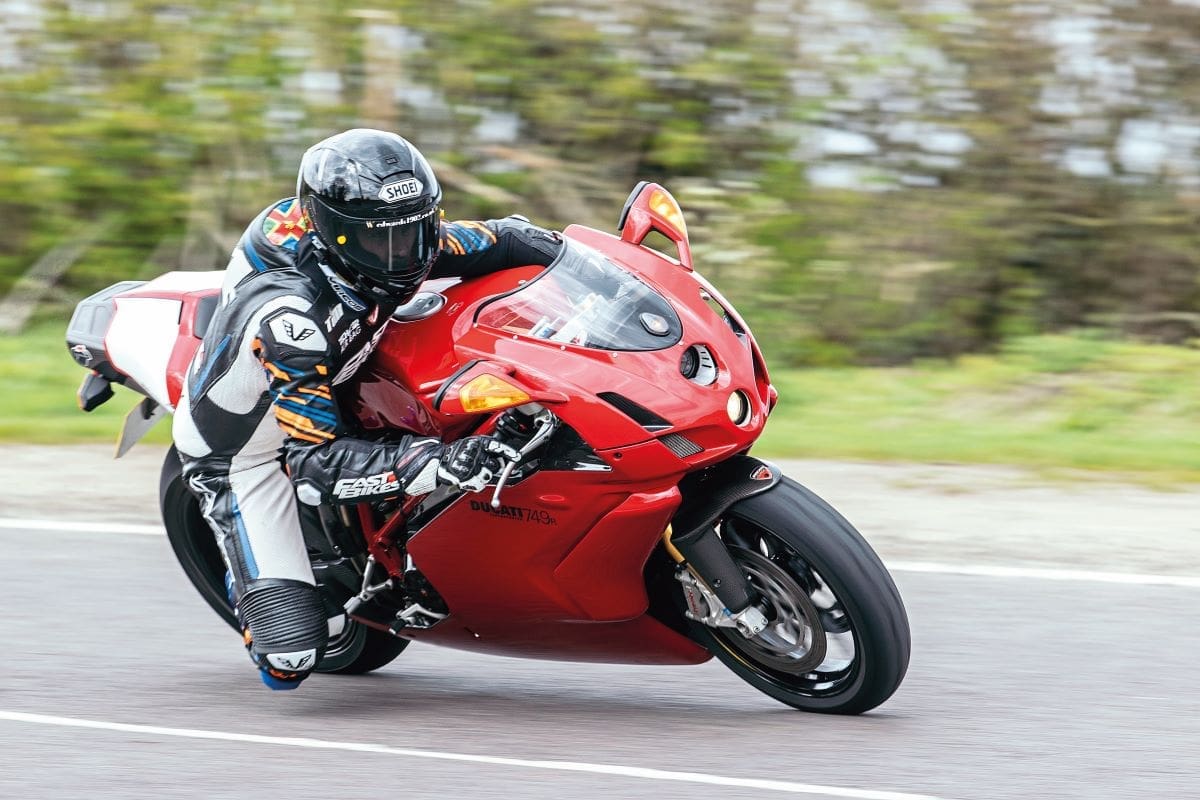
Words: Tim Neave
Pics: Chippy
It’s midway through the Noughties and the Japanese manufacturers are running away with the World Supersport Championship, dominating the middleweight sportsbike market… a red rag to a bull, if you ask any Italian, but of course Ducati had something up its sleeve to put a stop to that – the 749R. This old-school Duke is far more than just a pretty face or a dancing beauty in a red dress; it is a distinctive machine hosting a whole accolade of goodies and features derived from a long-lasting bloodline, and I’m here to tell you why I thought the riding experience was just as special as it looks.
Enjoy everything More Bikes by reading the monthly newspaper, Read FREE Online.
Before I jump the gun, I’d best put up my hand and own up to the fact that this was my first time riding a Ducati 749R, and with very limited knowledge on this particular model, I had to do some fact-finding to educate myself. The model first hit the scene in 2004 and was basically designed to be a more affordable version of the 999R, Ducati’s top-tier machine at the time; you could call it the little brother, if you like. It was built using many of the same components as the 999R but with a smaller engine and a lower price tag, thus maintaining the class while appealing to a much wider audience.
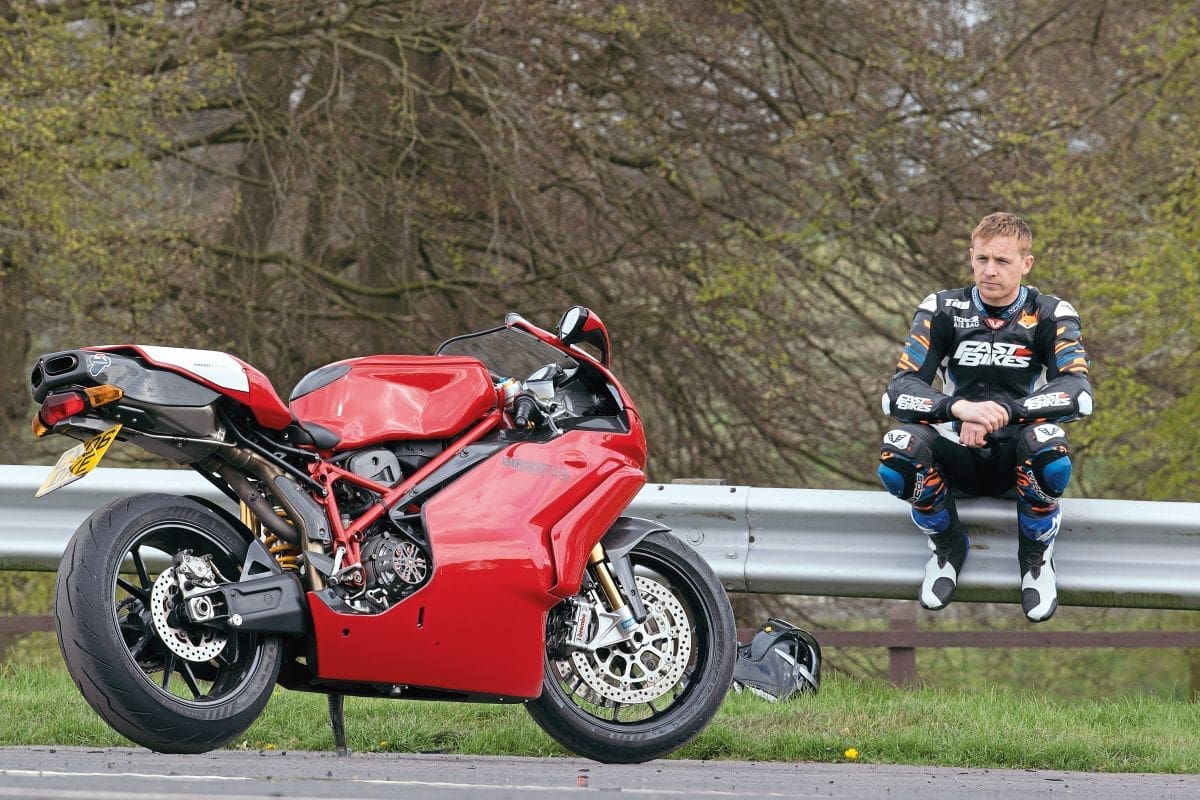
The liquid-cooled, 90-degree V-twin powerhouse produces 121 horsepower at 10,500rpm and 60lb-ft of torque at 8500rpm, and a weighbridge ticket of only 173kg means it’s fairly nifty when it comes to winding it up. It features a six-speed transmission, a dry slipper clutch (and no, it does not sound like a bag of spanners), and a lightweight aluminium frame. The suspension is fully-adjustable Öhlins, an improvement on the Showa forks and Sachs shock that comes with the standard model, and on the braking front, the 749R uses radial Brembo calipers. You get an 18.3-litre fuel tank on the R model, precisely 2.8 litres bigger than the standard model tank, and this design specification was purely for racing homologation purposes so that Ducati could finish the lengthy World Supersport races, but the added range of up to 30 miles was a cushty bonus for the road rider too.
Together with its big brother, the 999R, a unique new box section swingarm, similar to those used in Superbikes and MotoGP, was introduced to the production line for the first time in 2004 and it’s fair to say it was a hit for both the road and racing crowd alike, as not only was it prettier, lighter, stronger and more rigid, but it was now also possible to fit rear stand bobbins which had been a lacking feature on previous single-sided Ducatis. The new swingarm also allowed for improved chain adjustment sliders instead of a cheap design cam mechanism, which also meant that chain tension adjustments would no longer affect the suspension.
The 749R also came with reduced footrest adjustability, which may sound like a negative, but to comply with World Supersport regulations, they had to go from five adjustment holes to two, but this also allowed more space for larger diameter exhaust systems which were needed on the racing scene.
Priced at about £12,000 when it was released, the 749R was obviously a popular choice among riders who wanted a high-performance sportsbike without the high price tag of the 999R (or the extra horsepower – no comment). In true Italian style, a pure-bred race bike had been built for the special purpose of homologation for the World Supersport Championship and so naturally it was a hit on the racing scene, where it was used as a platform to help develop Ducati’s racing technology. Unfortunately, the results were not quite the hit they desired and so in 2006, the 749R was replaced by the 848, a completely new model. However, the 749R still remains a sought-after machine by riders and collectors who appreciate its combination of performance, handling and style. With only a limited number produced, it was and still is a relatively rare and exclusive bike.
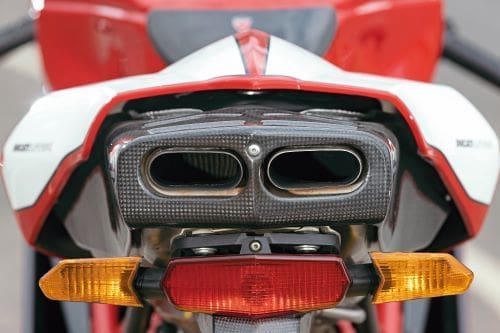
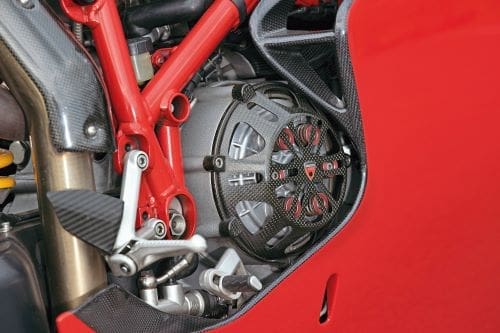

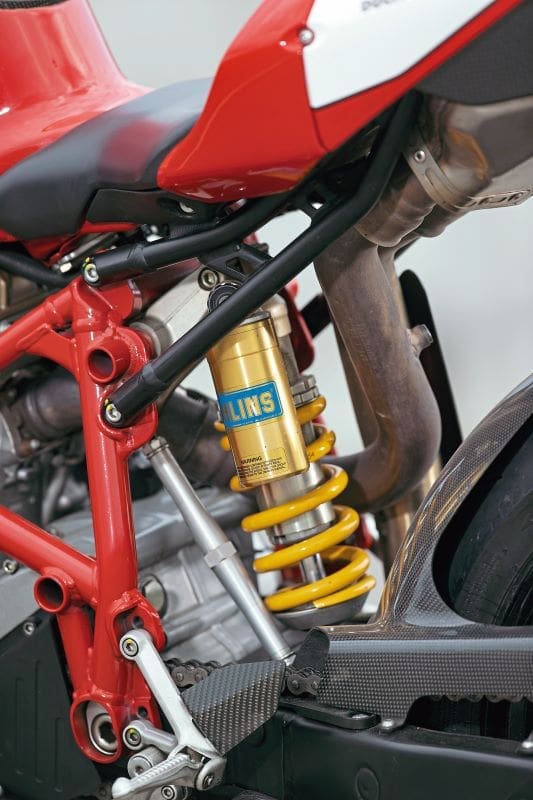


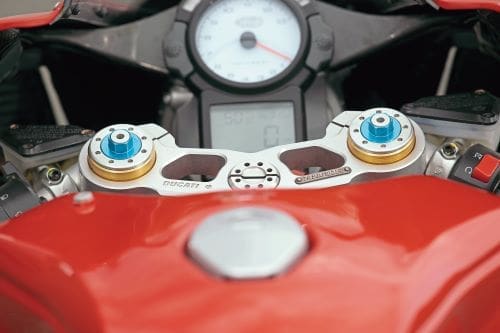
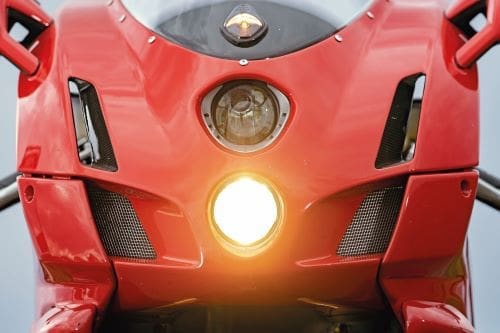
So, let’s talk about the riding experience… but first of all, I just want to address its looks. Phwoar, she’s a beauty alright, and there’s no shadow of doubt that the design and aesthetics have stood the test of time. There is only one teeny weeny part of this bike that I don’t appreciate, and that is the gap between the front of the tank and the yokes. Admittedly, it’s where the Öhlins steering damper and key ignition is positioned, so it does serve a purpose, but it just looks empty and as though it should have been filled up, in my humble opinion. Anyhow, the ruby-red majestic body is truly a work of art, and the built-in wing mirrors, over and under headlights and racy air intakes really sets its image apart from the rest. At 17 years old, it still manages to look futuristic. Moving around to the back of the bike, the seat unit is just as striking: flat and wide, with a fat carbon-wrapped Termignoni poking out from underneath and cooling vents to add to the aero package and the racy look. The leather seat is shaped with the rider in mind and holds you in place while giving more than enough wiggle room to move around, which I found ideal when flicking it from one corner and into the next… and that brings me perfectly onto my next point… rideability. The narrow V-twin motor makes for a super skinny chassis and a tapered tank which honestly gives the most nibble of sensations when it comes to hanging off the bike and changing direction. I felt at one with the bike, and with little body interaction was able to flick the bike from left to right with ease, always feeling connected and planted to the road. This bike is absolutely in its element when it comes to fast-flowing corners. Just imagine what it would be like on a racetrack… oh, stop it!
With a tank that sits quite high up on the chassis, when it’s brimmed it does feel very top-heavy and you don’t half notice the extra capacity and weight while manoeuvring the bike around, but when you get it out on the road and up to speed, the feeling of heaviness soon disappears.
It was a hot day when we were out riding, probably up to the 20 degrees mark, and in the towns and in slower-moving traffic, the old girl really felt the effects and it was a real struggle to keep the water temperature below 100 degrees. That wasn’t the only thing hotting up; the inside of my right leg was right in the firing line of the underseat exhaust link pipe, which I say is too close for comfort on any given day, least of all a hot one… heated seats are not an optional extra on this beast, they are just on – all of the time.
As with any older bike, the brakes always take a little bedding in and warming up, but once they came to life, they were spot-on. They wouldn’t win a braking competition against today’s calipers and master cylinders, but I can’t say they were causing me any bother with hauling this beauty up.
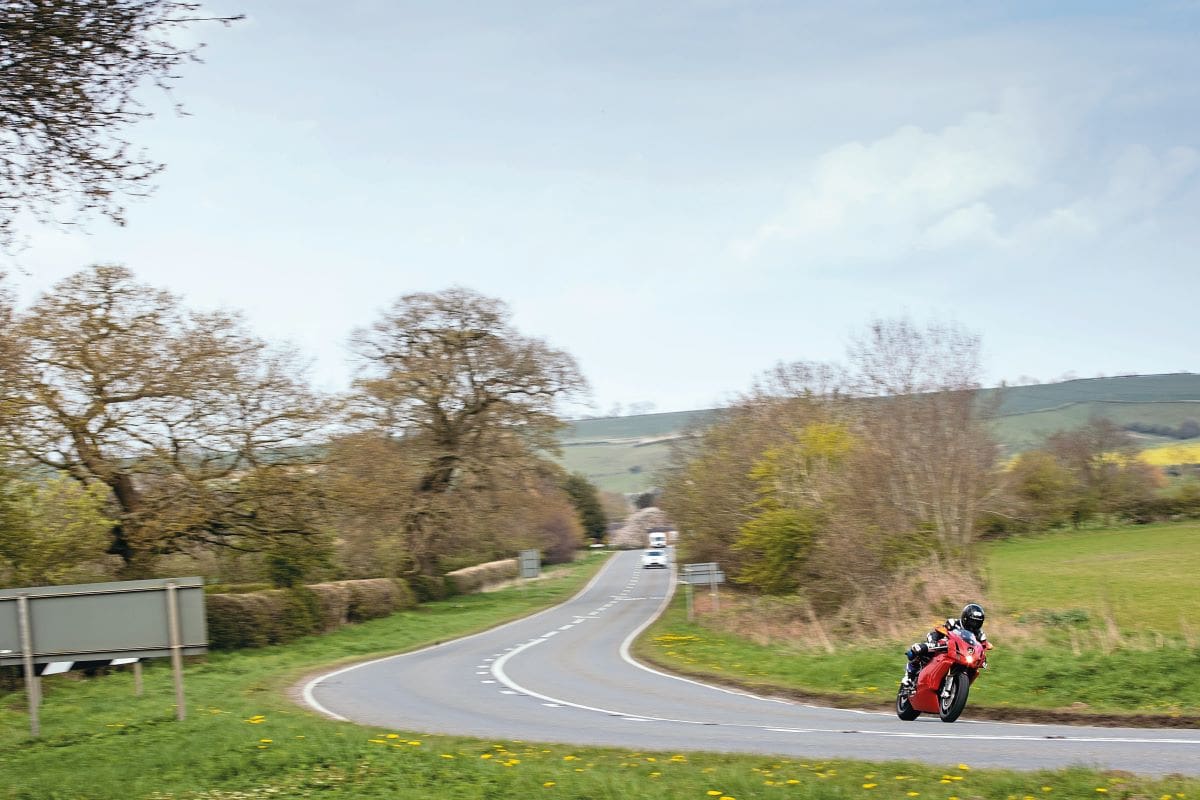
Packing a claimed 121 horses, it’s not the pokiest of bikes out there, nor is it supposed to be, but get it in the right gear and this bike really comes to life and is so rewarding to ride. I guess you could call it a real rider’s bike, whereby the rider’s input will always make the biggest difference to the performance, and I’m gonna put a big emphasis on gear selection. I didn’t need a gear indicator on the dash, but would I have liked one? Of course. It’s always nice to be able to have a glance down as you go back the gears and sling it into a corner, and it gives me peace of mind knowing I’m not going back to first before dumping the clutch and over-revving the bike. Thankfully, that didn’t happen. The fuelling was bang-on and it didn’t suffer with any flat spots, which did come as a surprise. I don’t know why, maybe because it’s an old Ducati? That’s discrimination for you. Mechanically, it was pretty sound across the board, I only really suffered with random stalling at the traffic lights a few times but I think a quick tweak up on the idle screw would have sorted that, and thankfully the electric start didn’t give up the ghost so I was always able to get it going before anybody noticed.
This bike is most definitely built for the track, and that was evident about an hour into the ride. As much as I love the riding position, it’s very racy and ‘in your arms’, so to speak. The low clip-ons and scrunched-up riding position is perfect for a quick blap around the Lincolnshire Wolds, but we decided we wanted a fry-up in Scarborough… you know what they say, hindsight is a beautiful thing. It certainly isn’t the bike of choice for long-distance comfort, and after 200-plus miles, my lower back undeniably started to surrender, but did it turn heads on the seafront? Hell yes, it did! That’s what having a sportsbikes on the road is all about, isn’t it?
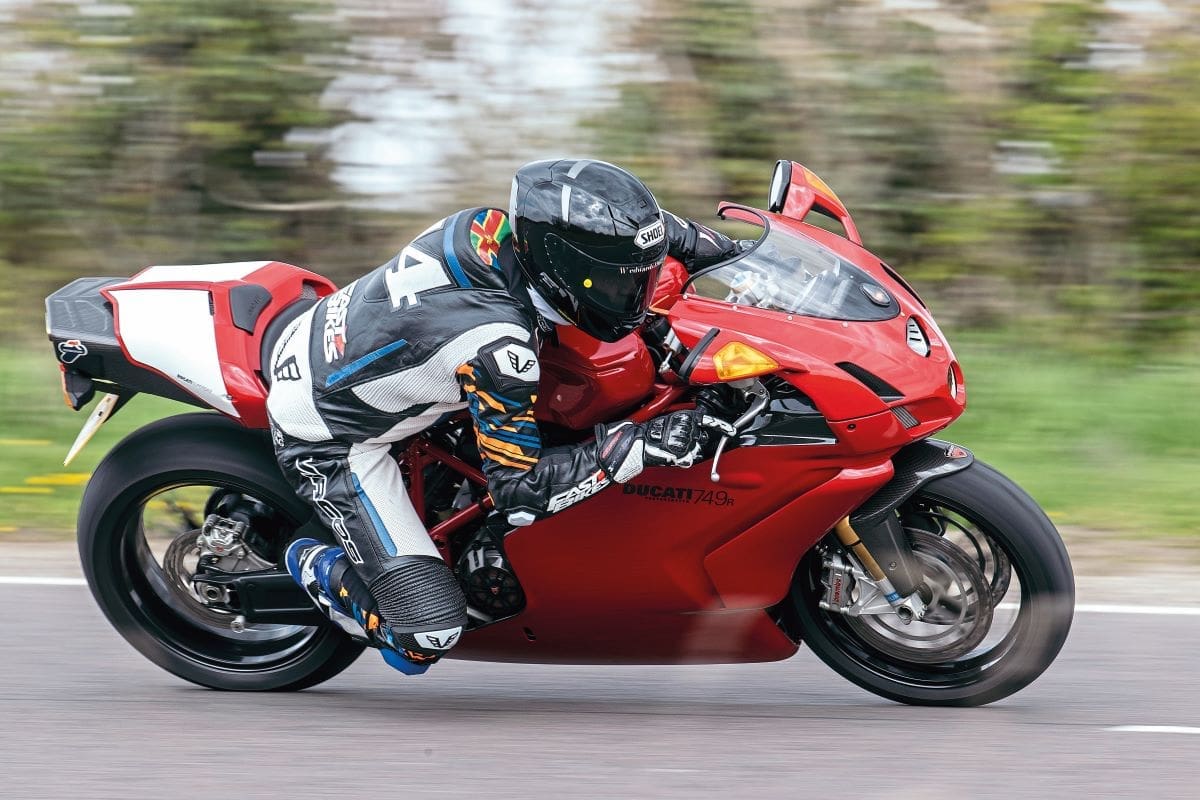
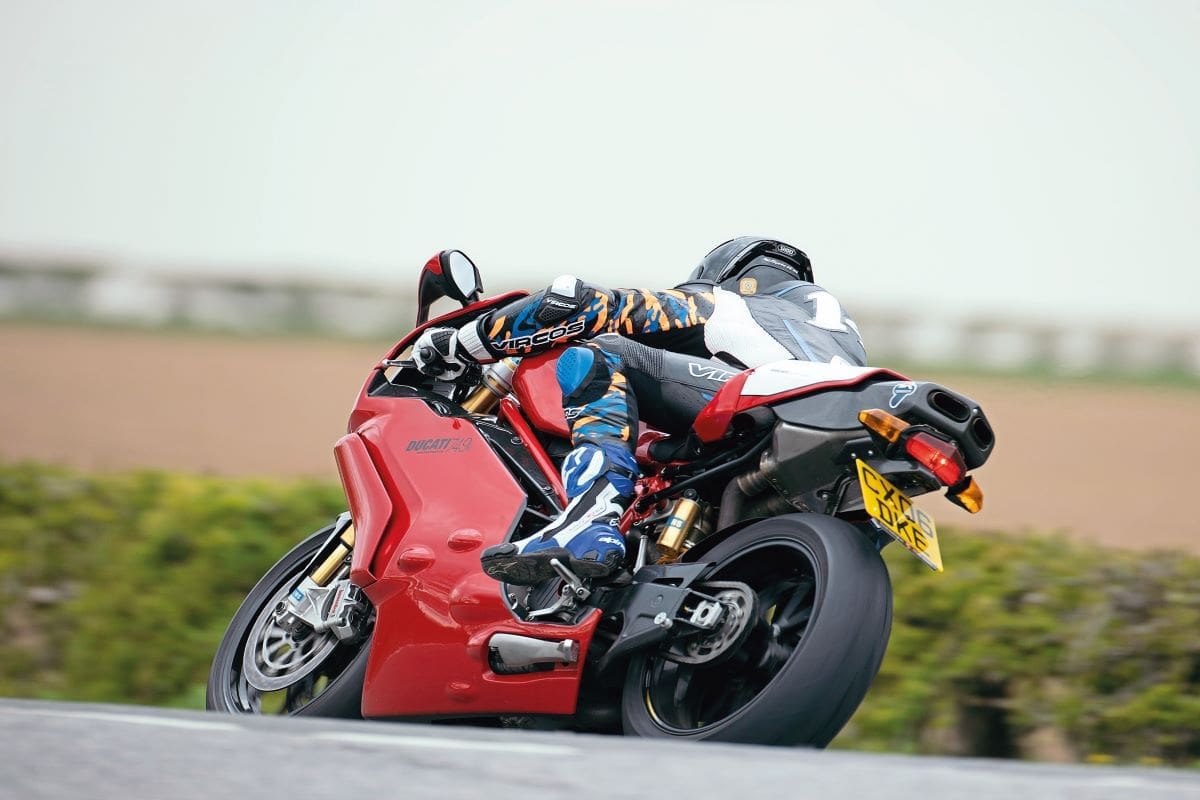
To end on a high note, I must mention the sound of this weapon (see what I did there). Ducatis are known for their distinctive soundtrack and it’s clear that the 749R hasn’t fallen far from the tree in this respect. The deep and throaty growl most definitely adds to the overall excitement and experience of riding this bike, whether it’s cracking the bike into life, banging it down the gears with a blip of the throttle, or accelerating hard out of a corner, the sound of piece of exotica never fails to put a smile on my face.
Can I hang onto it for a little longer?
Just under a decade ago, Ducati pulled the covers off a very special supersport bike. Here’s Timmy’s take on the iconic 749R.
Words: Tim Neave Pics: Chippy
It’s midway through the Noughties and the Japanese manufacturers are running away with the World Supersport Championship, dominating the middleweight sportsbike market… a red rag to a bull, if you ask any Italian, but of course Ducati had something up its sleeve to put a stop to that – the 749R. This old-school Duke is far more than just a pretty face or a dancing beauty in a red dress; it is a distinctive machine hosting a whole accolade of goodies and features derived from a long-lasting bloodline, and I’m here to tell you why I thought the riding experience was just as special as it looks.
Before I jump the gun, I’d best put up my hand and own up to the fact that this was my first time riding a Ducati 749R, and with very limited knowledge on this particular model, I had to do some fact-finding to educate myself. The model first hit the scene in 2004 and was basically designed to be a more affordable version of the 999R, Ducati’s top-tier machine at the time; you could call it the little brother, if you like. It was built using many of the same components as the 999R but with a smaller engine and a lower price tag, thus maintaining the class while appealing to a much wider audience.
The liquid-cooled, 90-degree V-twin powerhouse produces 121 horsepower at 10,500rpm and 60lb-ft of torque at 8500rpm, and a weighbridge ticket of only 173kg means it’s fairly nifty when it comes to winding it up. It features a six-speed transmission, a dry slipper clutch (and no, it does not sound like a bag of spanners), and a lightweight aluminium frame. The suspension is fully-adjustable Öhlins, an improvement on the Showa forks and Sachs shock that comes with the standard model, and on the braking front, the 749R uses radial Brembo calipers. You get an 18.3-litre fuel tank on the R model, precisely 2.8 litres bigger than the standard model tank, and this design specification was purely for racing homologation purposes so that Ducati could finish the lengthy World Supersport races, but the added range of up to 30 miles was a cushty bonus for the road rider too.
Together with its big brother, the 999R, a unique new box section swingarm, similar to those used in Superbikes and MotoGP, was introduced to the production line for the first time in 2004 and it’s fair to say it was a hit for both the road and racing crowd alike, as not only was it prettier, lighter, stronger and more rigid, but it was now also possible to fit rear stand bobbins which had been a lacking feature on previous single-sided Ducatis. The new swingarm also allowed for improved chain adjustment sliders instead of a cheap design cam mechanism, which also meant that chain tension adjustments would no longer affect the suspension.
The 749R also came with reduced footrest adjustability, which may sound like a negative, but to comply with World Supersport regulations, they had to go from five adjustment holes to two, but this also allowed more space for larger diameter exhaust systems which were needed on the racing scene.
Priced at about £12,000 when it was released, the 749R was obviously a popular choice among riders who wanted a high-performance sportsbike without the high price tag of the 999R (or the extra horsepower – no comment). In true Italian style, a pure-bred race bike had been built for the special purpose of homologation for the World Supersport Championship and so naturally it was a hit on the racing scene, where it was used as a platform to help develop Ducati’s racing technology. Unfortunately, the results were not quite the hit they desired and so in 2006, the 749R was replaced by the 848, a completely new model. However, the 749R still remains a sought-after machine by riders and collectors who appreciate its combination of performance, handling and style. With only a limited number produced, it was and still is a relatively rare and exclusive bike.
So, let’s talk about the riding experience… but first of all, I just want to address its looks. Phwoar, she’s a beauty alright, and there’s no shadow of doubt that the design and aesthetics have stood the test of time. There is only one teeny weeny part of this bike that I don’t appreciate, and that is the gap between the front of the tank and the yokes. Admittedly, it’s where the Öhlins steering damper and key ignition is positioned, so it does serve a purpose, but it just looks empty and as though it should have been filled up, in my humble opinion. Anyhow, the ruby-red majestic body is truly a work of art, and the built-in wing mirrors, over and under headlights and racy air intakes really sets its image apart from the rest. At 17 years old, it still manages to look futuristic. Moving around to the back of the bike, the seat unit is just as striking: flat and wide, with a fat carbon-wrapped Termignoni poking out from underneath and cooling vents to add to the aero package and the racy look. The leather seat is shaped with the rider in mind and holds you in place while giving more than enough wiggle room to move around, which I found ideal when flicking it from one corner and into the next… and that brings me perfectly onto my next point… rideability. The narrow V-twin motor makes for a super skinny chassis and a tapered tank which honestly gives the most nibble of sensations when it comes to hanging off the bike and changing direction. I felt at one with the bike, and with little body interaction was able to flick the bike from left to right with ease, always feeling connected and planted to the road. This bike is absolutely in its element when it comes to fast-flowing corners. Just imagine what it would be like on a racetrack… oh, stop it!
With a tank that sits quite high up on the chassis, when it’s brimmed it does feel very top-heavy and you don’t half notice the extra capacity and weight while manoeuvring the bike around, but when you get it out on the road and up to speed, the feeling of heaviness soon disappears.
It was a hot day when we were out riding, probably up to the 20 degrees mark, and in the towns and in slower-moving traffic, the old girl really felt the effects and it was a real struggle to keep the water temperature below 100 degrees. That wasn’t the only thing hotting up; the inside of my right leg was right in the firing line of the underseat exhaust link pipe, which I say is too close for comfort on any given day, least of all a hot one… heated seats are not an optional extra on this beast, they are just on – all of the time.
As with any older bike, the brakes always take a little bedding in and warming up, but once they came to life, they were spot-on. They wouldn’t win a braking competition against today’s calipers and master cylinders, but I can’t say they were causing me any bother with hauling this beauty up.
Packing a claimed 121 horses, it’s not the pokiest of bikes out there, nor is it supposed to be, but get it in the right gear and this bike really comes to life and is so rewarding to ride. I guess you could call it a real rider’s bike, whereby the rider’s input will always make the biggest difference to the performance, and I’m gonna put a big emphasis on gear selection. I didn’t need a gear indicator on the dash, but would I have liked one? Of course. It’s always nice to be able to have a glance down as you go back the gears and sling it into a corner, and it gives me peace of mind knowing I’m not going back to first before dumping the clutch and over-revving the bike. Thankfully, that didn’t happen. The fuelling was bang-on and it didn’t suffer with any flat spots, which did come as a surprise. I don’t know why, maybe because it’s an old Ducati? That’s discrimination for you. Mechanically, it was pretty sound across the board, I only really suffered with random stalling at the traffic lights a few times but I think a quick tweak up on the idle screw would have sorted that, and thankfully the electric start didn’t give up the ghost so I was always able to get it going before anybody noticed.
This bike is most definitely built for the track, and that was evident about an hour into the ride. As much as I love the riding position, it’s very racy and ‘in your arms’, so to speak. The low clip-ons and scrunched-up riding position is perfect for a quick blap around the Lincolnshire Wolds, but we decided we wanted a fry-up in Scarborough… you know what they say, hindsight is a beautiful thing. It certainly isn’t the bike of choice for long-distance comfort, and after 200-plus miles, my lower back undeniably started to surrender, but did it turn heads on the seafront? Hell yes, it did! That’s what having a sportsbikes on the road is all about, isn’t it?
To end on a high note, I must mention the sound of this weapon (see what I did there). Ducatis are known for their distinctive soundtrack and it’s clear that the 749R hasn’t fallen far from the tree in this respect. The deep and throaty growl most definitely adds to the overall excitement and experience of riding this bike, whether it’s cracking the bike into life, banging it down the gears with a blip of the throttle, or accelerating hard out of a corner, the sound of piece of exotica never fails to put a smile on my face.
Can I hang onto it for a little longer?
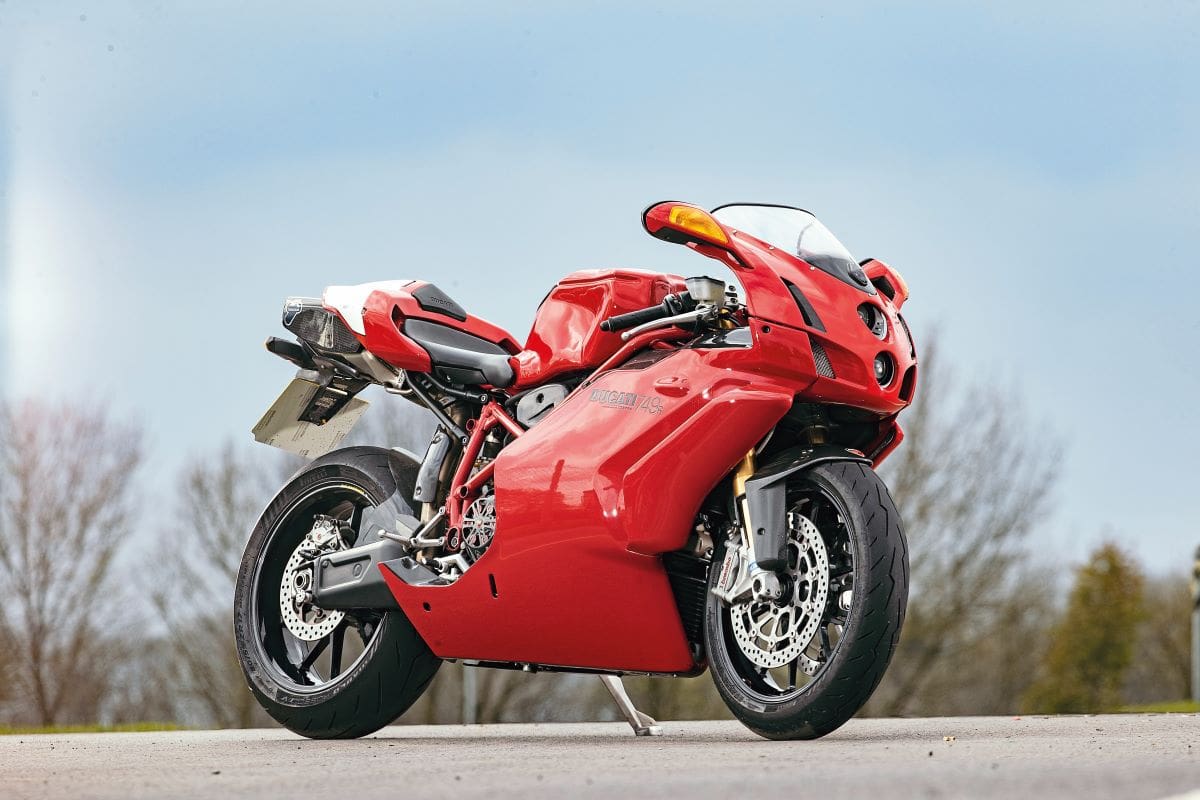
Tech Data
2004 Ducati 749R
Engine
Type: 749.5cc, liquid-cooled, dohc, 8v L-twin
Bore x stroke: 94mm x 54mm
Compression: 12.7:1
Fuelling: EFI, twin injectors per cylinder
Claimed power: 121bhp @ 10,250rpm
Claimed torque: 62.2 lb-ft @ 8500rpm
Chassis
Frame: Tubular steel trellis
F suspension: 43mm Öhlins USD, fully adjustable
R suspension: Öhlins Monoshock, fully adjustable
Front brakes: Four-piston Brembo monobloc radial calipers, 320mm discs
Rear brake: Single-piston caliper, 245mm single disc
Electronics
Riding modes: No
Traction control: No
Slide control: No
ABS: No
Quickshifter/autoblipper: No
Wheelie control: No
Launch control: No
Pit limiter: No
Cruise control: No
Dimensions
Wheelbase: 1420mm
Seat height: 780mm
Wet weight (claimed): 193kg
Fuel capacity: 15.5 litres
INFO
Price: (From) £10,000
From: Used bike sales
Advert
Enjoy everything More Bikes by reading the MoreBikes monthly newspaper. Click here to subscribe, or Read FREE Online.


